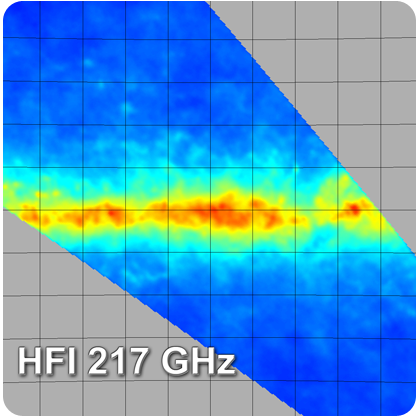|
|
The panel above zooms in on a small part of the Planck First Light Survey, in which our own Milky Way shines very brightly. The panel show a 20°×20° map of the emission imaged by Planck's Low-Frequency Instrument at 30 GHz. This is one of a series of 9 images from the Planck First Light Survey, covering the 9 frequencies to which Planck is sensitive, depicting a region where our Milky Way Galaxy shines very brightly.
|
The panel above zooms in on a small part of the Planck First Light Survey, in which our own Milky Way shines very brightly. The panel show a 20ox20o map of the emission imaged by Planck's Low-Frequency Instrument at 44 GHz. This is one of a series of 9 images from the Planck First Light Survey, covering the 9 frequencies to which Planck is sensitive, depicting a region where our Milky Way Galaxy shines very brightly.
|
|
|
The panel above zooms in on a small part of the Planck First Light Survey, in which our own Milky Way shines very brightly. The panel show a 20°×20° map of the emission imaged by Planck's Low-Frequency Instrument at 70 GHz. This is one of a series of 9 images from the Planck First Light Survey, covering the 9 frequencies to which Planck is sensitive, depicting a region where our Milky Way Galaxy shines very brightly.
|
The panel above zooms in on a small part of the Planck First Light Survey, in which our own Milky Way shines very brightly. The panel show a 20°×20° map of the emission imaged by Planck's High-Frequency Instrument at 100 GHz. This is one of a series of 9 images from the Planck First Light Survey, covering the 9 frequencies to which Planck is sensitive, depicting a region where our Milky Way Galaxy shines very brightly.
|
|
 |
The panel above zooms in on a small part of the Planck First Light Survey, in which our own Milky Way shines very brightly. The panel show a 20°×20° map of the emission imaged by Planck's High-Frequency Instrument at 143 GHz. This is one of a series of 9 images from the Planck First Light Survey, covering the 9 frequencies to which Planck is sensitive, depicting a region where our Milky Way Galaxy shines very brightly.
|
The panel above zooms in on a small part of the Planck First Light Survey, in which our own Milky Way shines very brightly. The panel show a 20°×20° map of the emission imaged by Planck's High-Frequency Instrument at 217 GHz. This is one of a series of 9 images from the Planck First Light Survey, covering the 9 frequencies to which Planck is sensitive, depicting a region where our Milky Way Galaxy shines very brightly.
|
|
|
The panel above zooms in on a small part of the Planck First Light Survey, in which our own Milky Way shines very brightly. The panel show a 20°×20° map of the emission imaged by Planck's High-Frequency Instrument at 353 GHz. This is one of a series of 9 images from the Planck First Light Survey, covering the 9 frequencies to which Planck is sensitive, depicting a region where our Milky Way Galaxy shines very brightly.
|
The panel above zooms in on a small part of the Planck First Light Survey, in which our own Milky Way shines very brightly. The panel show a 20°×20° map of the emission imaged by Planck's High-Frequency Instrument at 545 GHz. This is one of a series of 9 images from the Planck First Light Survey, covering the 9 frequencies to which Planck is sensitive, depicting a region where our Milky Way Galaxy shines very brightly.
|
|
|
The panel above zooms in on a small part of the Planck First Light Survey, in which our own Milky Way shines very brightly. The panel show a 20°×20° map of the emission imaged by Planck's High-Frequency Instrument at 857 GHz. This is one of a series of 9 images from the Planck First Light Survey, covering the 9 frequencies to which Planck is sensitive, depicting a region where our Milky Way Galaxy shines very brightly.
|
|
![]()
![]()